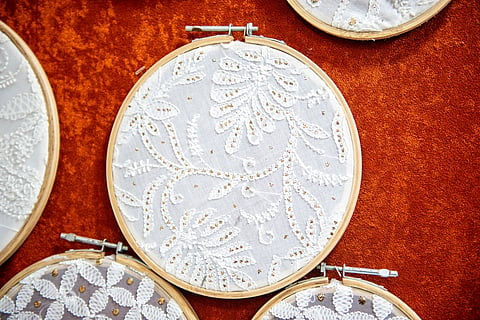
- Destinations
- Experiences
- Stay
- What's new
- Celebrating People
- Responsible Tourism
- CampaignsCampaigns
- Subscribe
- Buy Now

This fall, when I was on my way back to my city, Lucknow, for a month's holiday, I was sure that I wanted to take some part of the city&rsquos crafts back to Bengaluru. During my stay in Bengaluru, I had realised that to survive in the urban chaos, I needed the sukoon (peace) of Awadh. And one of the beauties that would undoubtedly give me the essence of my city back was Lucknow&rsquos Chikankari work. Delicate, royal, elegant, and luxurious, the Chikankari work of Lucknow has ardent admirers across the world. You can find the embroidery work on shararas, lehengas, anarkalis, angarkhas, kurtas, coats, and sherwanis.
Forgotten Origins
And so I found myself one day walking down the narrow lanes of Chowk Bazaar in Lucknow, in my search for an angrakha with Chikakari work. The streets had pretty shararas and anarkalis hanging everywhere. I could see that the recent fusion of gotta-patti and Chikankari had added another layer to the already lively embroidery scene in the old city. But I was here to get to the root of the craft of Chikankari.
Walking around the bazaar, I stumbked upon Umar Miyan&rsquos garibkhana (house) where I sensed an unspoken nostalgia for this exquisite craft. Umar Miyan was a middle-aged man with hands reflecting the threadwork created over the years, and eyes speaking of an era he was longing to share stories about. While he was showing me beautifully woven threadwork pieces on georgette fabric, I asked him about the origins of the craft of Chikankari. The original white-on-white embroidery is believed to have originated in Persia, he replied. "The embroidery was done on muslin cloth then. The Persian nobles brought it into the Moghul courts, and Mallika-e-Jahan Nur Jahan, the wife of Emperor Jehangir nurtured it by patronising the art."
It was evident that Umar Miyan wanted to talk about his craft some more. He instructed someone to bring some elaichi chai and continued the conversation. The court of Awadh shifted to Lucknow in the 18th century, he said, and as Nawab Wazir-Asaf Ud-Daula loved art and luxury, the galiyaaras of Lucknow became a hotspot for handicrafts like Chikankari.
Tales of Elegance
Chikankari work was originally done on tanzeb (muslin fabric) and was only worn by the women of elite classes in cities like Hyderabad. During the British era, it was thought to be a symbol of being eligible for marriage within the same class. However, the evolution of this art form led to it being used on many household items like pillow covers, cushions, and even bedsheets in contemporary times.
Chikankari and its beauty have also been described by the Greek traveller Megasthenes, who was touring India during the third century BCE. It is possible that the word is derived from the Persian word 'Chakeen', which referred to a coin of the value of four rupees for which the Chikankari work would be available.
Chikankari uses mainly floral motifs. This comes from the Moghuls who were deeply influenced by Persian culture and had a predilection towards nature and landscapes. They used floral designs not only on their legendary monuments (like the Taj Mahal, Agra Fort, and Fatehpur Sikri) but also on their clothes.
Umar Miyan had said that there were three main Chikankari stitches embossed, flat, and jaali. And these stitches have twenty sub-stitches known as bakhya, hool, hatkati, murri, and more. These embroideries are first imprinted on the cloth using wooden blocks made of sheesham and sal trees. They are used as a stencil for the embroidery to demarcate the different areas of focus in the patterns. Originally, muslin cloth was used as the base fabric. The designs consisted of flowers, creepers, paisleys, and jaalis, inspired by nature and Moghul architecture. However, around the 1980s, cotton and the synthetic fabric came into the picture, which is how Chikankari reached ordinary people.
The Luxe Chikankari
During the conversation with Umar Miyan, I was intrigued to know about the more contemporary connection between luxury labels like Abu Jani-Sandeep Khosla and Sabyasachi and their adoption of Chikankari work. I decided to get in touch with Manoj Prasad of Shiv Exports from Chowk Bazaar in Lucknow. They explained that luxury brands were showcasing Chikankari because the elite audience wants something elegant yet subtle.
The threadwork is intricate and it can take as long as six months to a year to carve out a beautiful bridal lehenga or sharara. This is why the cost of each of their Chikankari ensembles is priced high. The adoption of Chikankari work by such labels can be seen as a good sign contributing to the resurgence of the art.
After browsing through his shop, I bought my anarkali kurta and exchanged salutations with a promise to stay in touch with him. If you wish to meet Umar Miyan, you can find him in Chowk Bazaar, sitting in his small and narrow shop number eleven which is decorated with Chikankari work on chunnis and shararas.
The conversations in Chow Bazaar will stay with me, and every time I wear my Chikankari kurta, I will relive the moments I had spent with Umar Miyan. My days in Bengaluru will indeed have a part of Lucknow woven in this time. I will be the one carrying forward the legacy of Chikankari in my own way.
